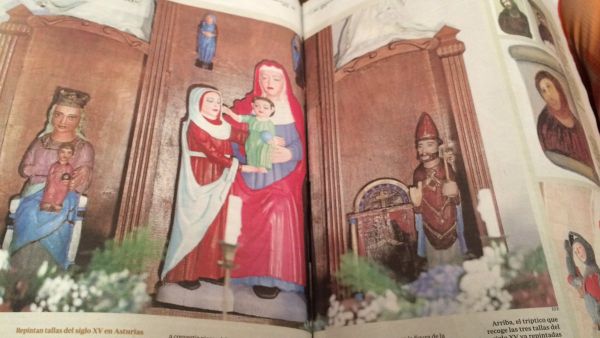A Spanish shop owner has been accused of an 'aberration' after an amateur restoration of three 15th century sculptures which included eyeliner and pink lipstick for the Virgin Mary.
Maria Luisa Menendez, one of only 16 inhabitants in the tiny village of Ranadoiro in the northern province of Asturias, is said to have produced the eye-catching result with the permission of local priest Arturo Garcia.
The Virgin Mary ended up with turquoise green hair in one of the three sculptures and Baby Jesus with a look which has been compared to a Playmobil figure.
Luis Saro, the last person to restore the sculptures before tobacco shop owner Maria Luisa got to work, has branded them a 'disaster and an aberration.'
The makeover has led to comparisons with the famous 'Ecce Homo' saga in Borja near Zaragoza after an elderly Spanish artist tried to give a painting of Christ a facelift.
In July restoration work began on a 500-year-old effigy of St George after a Spanish handicraft teacher was accused of it leaving it looking like a 'fairground carousel ride' with a non-expert restoration in the town of Estella in the province of Navarra.
The three sculptures at the centre of the latest row - housed in the village chapel in Ranadoiro - are estimated to date from the 15th and 16th centuries.
One represents the Virgin Mary with Baby Jesus and Saint Anne, the mother of Mary. The other two represent Saint Peter and the Virgin Mary with Baby Jesus.
Maria Luisa, who has received support from her neighbours, hit back on Friday by insisting she had simply used colours she liked for the facelift and claimed they were horrible before she transformed them.
She told a local paper: 'I'm not a professional but they were horrible and I wanted to paint them to make them look better.
'I had the priest's permission. I painted them in the colours that took my fancy, that was all.'
Mr Saro said he wanted try to return the sculptures to their original appearance but the paint used on them could make it impossible.
He said: 'A proper analysis will have to be done to know for sure.'
Estella mayor Koldo Leoz admitted the results left 'something to be desired' after the restoration of the 16th century effigy of St George and the Dragon which made headlines before the Ranadoiro makeover.
Untrained Cecilia Gimenez's botched attempt to restore the fresco of Christ in 2012 in Borja sparked ridicule and led to claims by critics the face of Christ had been turned into a 'hairy monkey.'
In July this year it was announced that a 500-year-old effigy of St. George needed a full restoration after a handicraft teacher's botched job left it looking like a 'fairground carousel ride.'
The sculpture of St George and the Dragon, which dates back to the 16th century, normally takes pride of place in the church of San Miguel in Estella, Navarra.
The results caused outrage in Navarra and further afield – with many blasting the sculpture as 'barely recognisable.'
The botched restoration led to comparisons with the 'Ecce Homo' saga which catapulted the small town of Borja after an elderly Spanish artist tried to give a painting of Christ a facelift.
The spectacularly bad results garnered worldwide attention and was dubbed one of 'the worst art restoration projects of all time'.
This article has been adapted from its original source.








